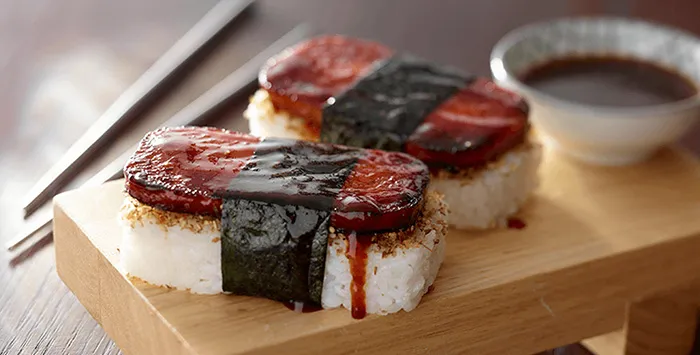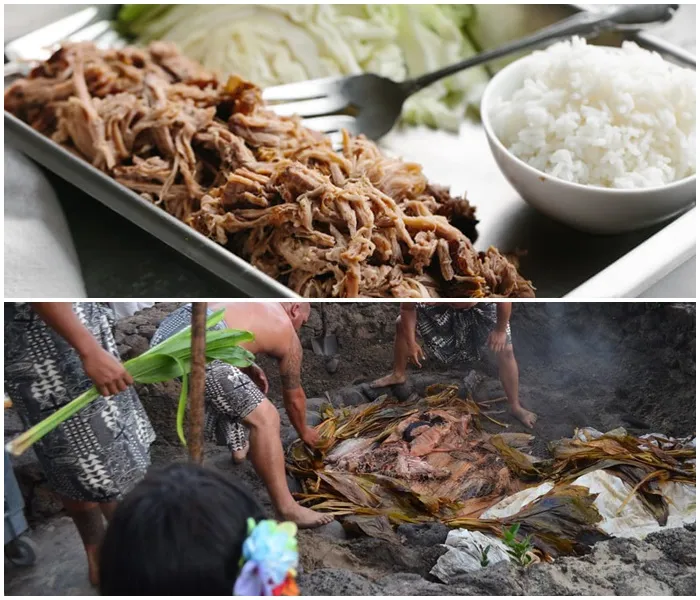Hawaii is not only famous for its blue beaches and stunning natural landscapes, but also a unique culinary paradise. Among countless delicious dishes, Spam Musubi stands out as a street food icon, conquering the hearts of locals and tourists alike. This dish is a harmonious combination of Japanese and American culinary cultures, creating a distinctive flavor that is unmistakably Hawaiian. Let’s explore how to make delicious and easy Spam Musubi right at home!
What is Spam Musubi?
Spam Musubi is a popular snack in Hawaii, shaped similarly to Japanese Onigiri rice balls. However, instead of traditional fillings like salmon or pickled plum, Spam Musubi uses grilled Spam (a processed pork product), placed on top of a block of white rice and secured with a strip of Nori seaweed. This dish is often enjoyed as a light meal, a quick lunch, or a convenient street food.

The Origin of Spam Musubi
The origin of Spam Musubi stems from the combination of Japanese culture and the influence of Spam in Hawaii. During World War II, Spam became popular in Hawaii due to limited fresh meat supplies. Local residents, especially those of Japanese descent, creatively invented Spam Musubi by combining Spam with rice and Nori seaweed in the style of traditional Japanese rice balls. This dish quickly gained popularity and became an indispensable part of Hawaiian cuisine.
Why is Spam Musubi so beloved?
Spam Musubi is loved for its simplicity, convenience, and distinctive delicious flavor. This dish is easy to carry and enjoy anywhere, from the beach to the park. The combination of the savory taste of grilled Spam, the sweetness of rice, and the sea flavor of Nori seaweed creates a harmonious and appealing taste. In addition, Spam Musubi is also a dish that evokes the unique history and culture of Hawaii.
Detailed Guide to Making Spam Musubi at Home
Here’s a detailed guide on how to make delicious, authentic Hawaiian Spam Musubi right in your kitchen:
Ingredients
- White rice: 2 bowls (use Japanese short-grain rice for better texture)
- Spam: 1 can
- Nori seaweed: 3-4 sheets
- Soy sauce: 2 tablespoons
- Sugar: 1 tablespoon
- Cooking oil
- Water
Instructions
- Prepare the ingredients:
- Open the Spam can and slice it into 1cm thick slices.
- Cut Nori seaweed sheets into strips about 3-4cm wide.
- In a small bowl, mix soy sauce and sugar, stirring until sugar is dissolved. This will be the sauce for marinating the Spam.
- Grill the Spam:
- Heat a little cooking oil in a pan.
- Add Spam slices to the pan and grill until golden brown on both sides.
- Once the Spam is golden brown, pour the prepared sauce over it, reduce heat to low and simmer until the sauce thickens and evenly coats the Spam.
- Turn off the heat and let the Spam cool slightly.
- Shape the rice:
- Prepare a rectangular rice mold (you can use a food container or make a mold from cardboard).
- Line the mold with plastic wrap.
- Place rice into the mold, use a spoon or your hands to gently press the rice firmly into a rectangular shape.
- Remove the rice from the mold.
- Assemble the Spam Musubi:
- Place a grilled Spam slice on top of the rice block.
- Wrap a Nori seaweed strip around the rice and Spam, securing it in place.
- Repeat the steps above until all ingredients are used.

Tips for Making Delicious Spam Musubi
- Choose good rice: Use Japanese rice or other sticky rice varieties for the best texture and flavor.
- Adjust sauce amount: Adjust the amount of soy sauce and sugar in the Spam marinade to your taste.
- Grill Spam just right: Do not overcook Spam as it will become dry and hard.
- Press rice firmly but gently: Pressing rice too tightly will make it hard, pressing too loosely will cause the Spam Musubi to fall apart easily.
- Use a rice mold: A rice mold will help you shape Spam Musubi easily and neatly.
- Add other ingredients: You can add other ingredients to Spam Musubi such as fried egg, pickled cucumber, kimchi, or mayonnaise to enhance the flavor.
Variations of Spam Musubi to Your Liking
Spam Musubi is a very versatile dish that can be customized to your personal preferences. Here are a few suggestions for creating unique Spam Musubi versions:
- Spam Musubi with Fried Egg: Add a thin layer of fried egg between the rice and Spam.
- Spam Musubi with Kimchi: Add stir-fried kimchi between the rice and Spam for a spicy kick.
- Teriyaki Spam Musubi: Marinate Spam with teriyaki sauce instead of soy sauce and sugar.
- Furikake Spam Musubi: Sprinkle a layer of furikake (Japanese rice seasoning) on top of the rice.
- Avocado Spam Musubi: Add a few slices of avocado between the rice and Spam.
How to Enjoy Spam Musubi Properly
Spam Musubi is usually enjoyed as a snack, a quick lunch, or a convenient street food. You can eat Spam Musubi directly with your hands or cut it into smaller pieces for easier eating. Spam Musubi is best enjoyed warm, but it is also delicious when cooled.

Spam Musubi – A Dish with Hawaiian Cultural Imprint
Spam Musubi is not just a delicious dish, but also a cultural symbol of Hawaii. This dish reflects the creativity, convenience, and ability to combine different cultures of the Hawaiian people. If you have the opportunity to visit Hawaii, don’t forget to enjoy Spam Musubi to fully experience the unique flavor and culture of this beautiful island.
Conclusion
Spam Musubi is a simple, easy-to-make dish that carries the distinctive flavor of Hawaii. With readily available ingredients and simple steps, you can absolutely make delicious Spam Musubi yourself to treat your family and friends. Try to vary Spam Musubi according to your preferences to create unique and interesting versions! Wishing you success and wonderful culinary experiences!